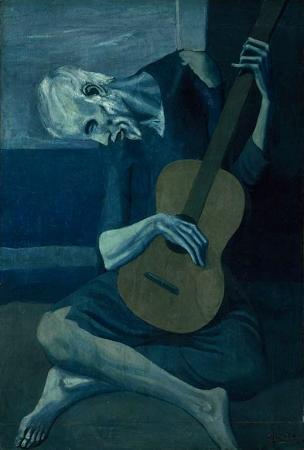Guitar Player (c1672). Oil on canvas. 53 x 46. The Guitar Player is an oil painting by Dutch Baroque artist Johannes Vermeer, dated c. 1672. This work of art is one of Vermeer's final artistic activities, providing insight into the techniques he mastered and approaches to painting he favored. The painting has been on display at Kenwood House, London since the 1920s, as part of the Iveagh Bequest collection. After being recovered from a theft in 1974, when the painting was held for ransom, The Guitar Player was returned to Kenwood House. Vermeer's artistic style in the 1670s is often compared to his earlier style of the mid-1660s. The Guitar Player properly demonstrates the energy of Vermeer's late style. His earlier paintings portray quiet self-contained worlds, but The Guitar Player is different. His late style demonstrated abstract painting techniques, in which the depiction of motion is portrayed through the diffused illustration of shifting objects. With Vermeer's experience, he began to create paintings that demonstrate dynamic poses and actions, implying that a movement is taking place. The Guitar Player is often compared to Vermeer's, Woman with a Lute. The Guitar Player represents a new direction in Vermeer's art. Because he developed and perfected compositional balance and harmony during the 1660s, he was able to expand and paint scenes that show imbalance and fluctuation. Vermeer's painting of The Guitar Player rejects compositional balance and harmony, which contradicts his previous paintings. This painting exhibits an unbalanced arrangement that depicts a lack of compositional consistency, but also rejects the past instrument of the lute to focus on the modern guitar. The rejection of the lute and depiction of the guitar may be linked to Vermeer's compositional organization. Vermeer painted the young guitar player far to the left, allowing the right half of the paining to be covered in light and shadow. This imbalance gives the viewer a sense of change and movement. The combination of an uneven arrangement conjoined with a gleam of light coming from the right rather than the left, forces the viewer to be engaged with the character and instrument in this painting. The compositional arrangement is reinforced by Vermeer's decision to specifically direct the light onto the guitar player, which helps the viewer feel the impact of her presence. As a result of Vermeer's decision to paint a single personality, a greater importance and focus is placed on the instrument. The inclusion of a pastoral landscape, dark curtains, three books, and a blue tablecloth provide a counterbalance to the overriding composition displayed on the left of this artwork. The late style of Vermeer utilized a number of painting techniques, most of which suggest an abstract style. His fascination with objects and actions that portray movement and sound are represented by an approach to painting that establishes objects as diffused and illuminated. In his painting, Vermeer integrated the use of abstraction through the strum of the guitar strings and movement of the right hand. Because this painting stayed with him until he died in 1675, we are to assume that this was his own stylistic direction, and not a request of a patron. In this painting, Vermeer depicts a young girl strumming a guitar. The instrument is placed comfortably on her lap while she plays near a window, sitting in the corner of a room. Her attire is made up of an ermine-bordered yellow jacket, an ivory-colored satin dress, and a pearl necklace. Surrounding her is a painted pastoral landscape bordered by an extravagant picture frame, a blank wall, three books, and a guitar. Prior to this painting, Vermeer portrayed individuals with obscure expressions. On the contrary, this young girl has an open expression that is joyous and flirtatious. The girl's smile and tipped head, along with the fixed gaze on something just outside the painting suggests that she is playing not for us, but for an unseen individual. Her dress and hairstyle reflect the relevant fashions of the wealthy Dutch, in that day. The young girl is portrayed with wholesome features and a free expression, as if she is in the act of speaking or singing. The joyous demeanor established in this painting is conveyed through the young girl's self expression, the peaceful landscape pictured behind her, and the soft tones of light and dark. Due to these factors, Vermeer is able to provoke feelings of calmness and contentment. The morning jacket portrayed in this painting resembles five separate Vermeer paintings, three of which are A Lady Writing a Letter, Mistress and Maid, and Woman with a Pearl Necklace.
more...




